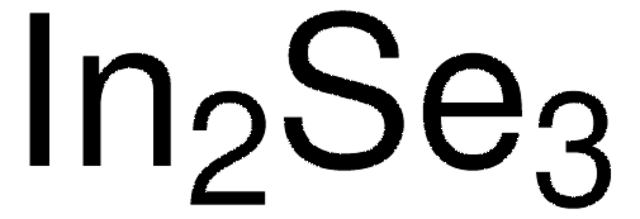This product has an acceptable appearance specification of Powder or Granules or Chunk(s). The physical form is lot-specific and reported in the product Certificate of Analysis. The particle size is not determined given the variability of the form. The material is not screened and the particle size is not controlled.
254231
Lead(II) selenide
99.99%
Seleccione un Tamaño
Seleccione un Tamaño
About This Item
Productos recomendados
Ensayo
99.99%
características de los productos alternativos más sostenibles
Design for Energy Efficiency
Learn more about the Principles of Green Chemistry.
sustainability
Greener Alternative Product
densidad
8.1 g/mL at 25 °C (lit.)
categoría alternativa más sostenible
, Enabling
cadena SMILES
[Se]=[PbH2]
InChI
1S/Pb.Se
Clave InChI
GGYFMLJDMAMTAB-UHFFFAOYSA-N
Categorías relacionadas
Descripción general
Aplicación
Envase
Palabra de señalización
Danger
Frases de peligro
Consejos de prudencia
Clasificaciones de peligro
Acute Tox. 3 Inhalation - Acute Tox. 3 Oral - Aquatic Acute 1 - Aquatic Chronic 1 - Repr. 1A - STOT RE 2
Código de clase de almacenamiento
6.1D - Non-combustible acute toxic Cat.3 / toxic hazardous materials or hazardous materials causing chronic effects
Clase de riesgo para el agua (WGK)
WGK 3
Punto de inflamabilidad (°F)
Not applicable
Punto de inflamabilidad (°C)
Not applicable
Equipo de protección personal
dust mask type N95 (US), Eyeshields, Gloves
Elija entre una de las versiones más recientes:
¿Ya tiene este producto?
Encuentre la documentación para los productos que ha comprado recientemente en la Biblioteca de documentos.
Artículos
Thermoelectric materials comprise a wide range of solid compounds distinguished by their ability to convert thermal and electrical energy.
-
What is the physical form of this material? I asuume it is a powder but what is the mesh/size characteristics?
1 answer-
Helpful?
-
Active Filters
Nuestro equipo de científicos tiene experiencia en todas las áreas de investigación: Ciencias de la vida, Ciencia de los materiales, Síntesis química, Cromatografía, Analítica y muchas otras.
Póngase en contacto con el Servicio técnico











